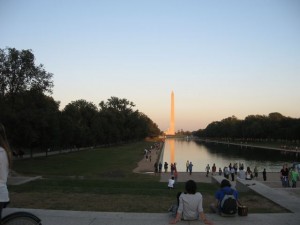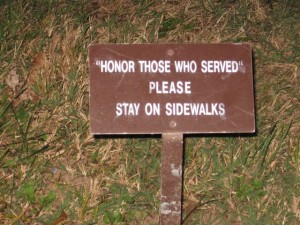Copyright 2010 Ben S. Pollock
WASHINGTON, D.C. — Sometimes you have to stop and think. Often thinking and writing looks like loafing. As Steinbeck wrote: “I write many thousands of words a day and some of them go on paper.” It can take quite a while. Visiting Washington’s Vietnam Veterans Memorial for the first time immediately jars and inspires, but further conclusions seep out for quite a while.
 I’ve visited Washington once as a 10-year-old, the second was summer 2000 and the third recently. While planning this weekend non-vacation, I saw that after the session I’d have about three hours. Don’t blow it, prioritize. I ruled out galleries and tours, and wheels. Instead walk to and through the National Mall, the Lincoln Memorial end. After a visit to Fahrney’s Pens.
I’ve visited Washington once as a 10-year-old, the second was summer 2000 and the third recently. While planning this weekend non-vacation, I saw that after the session I’d have about three hours. Don’t blow it, prioritize. I ruled out galleries and tours, and wheels. Instead walk to and through the National Mall, the Lincoln Memorial end. After a visit to Fahrney’s Pens.
I needed an Abe fix and only had driven by or flown over his memorial before. The statue has him wearing boots. Wouldn’t have known that if I couldn’t step right up. Not that I was expecting Birkenstock sandals.
It’s so close. If you have a really great arm, maybe you could hit the Vietnam monument with a rock. You’d no doubt be arrested, after the park police quit hassling the kids who were sliding down one side of the Lincoln’s stairs.

 I kept my emotions in check until the apex of the granite wall panels, on which the names of the fallen are engraved, then choked up. It’s that moving. Abstract artwork at its best, like this, beats cloying pseudo-realism. But as I moved along the now-shortening wall, grief became anger.
I kept my emotions in check until the apex of the granite wall panels, on which the names of the fallen are engraved, then choked up. It’s that moving. Abstract artwork at its best, like this, beats cloying pseudo-realism. But as I moved along the now-shortening wall, grief became anger.
The shift in mood is what took a while to figure out. Using World War II or even Vietnam as the comparison (some people today still call the 1950-53 event the Korean Conflict), it’s difficult to term current U.S. efforts in Western Asia “war,” unless it’s perpetual war.
Vietnam was my epochal war, right? If there’s one profound war per generation, the one in Southeast Asia should be mine. I was around 17 when it ended in 1974. If it lasted another year, I’d have faced the draft lottery.
 My country now has been battling on two if not three fronts: Iraq, Afghanistan and “terror,” which encompasses the first two yet moves past it into covert operations abroad and, worrisomely, stateside. The first Iraq war (as the government called it) was 1990-91 with the second beginning in 2003. The Afghan effort began in October 2001, directly after 9/11, a hunt for Osama bin Laden and his lieutenants. Was there peace through the 1990s? That was when bloodshed spouted from the breakup of the Soviet Union, especially in the Balkans. (It’s too easy to forget the genocidal wars in central Africa at this time.) During the decade, al-Qaida was building strength and making occasional attacks, like the 1993 World Trade Center bombing and 2000 USS Cole incident.
My country now has been battling on two if not three fronts: Iraq, Afghanistan and “terror,” which encompasses the first two yet moves past it into covert operations abroad and, worrisomely, stateside. The first Iraq war (as the government called it) was 1990-91 with the second beginning in 2003. The Afghan effort began in October 2001, directly after 9/11, a hunt for Osama bin Laden and his lieutenants. Was there peace through the 1990s? That was when bloodshed spouted from the breakup of the Soviet Union, especially in the Balkans. (It’s too easy to forget the genocidal wars in central Africa at this time.) During the decade, al-Qaida was building strength and making occasional attacks, like the 1993 World Trade Center bombing and 2000 USS Cole incident.
Is al-Qaida the enemy? When a nation of millions, which is supreme in military and economic strength, hunts down mere thousands, is that war?
Al-Qaida certainly is an enemy, dangerous far beyond its apparent numbers. But it’s a Hydra. When we lop off its head surely more will grow in its place. The names and goals of this enemy may change yet still be looming threats against the lands and people that comprise the United States.
Standing just after sunset on Saturday, Oct. 9, 2010, at the far end of the Vietnam memorial, looking back toward Lincoln’s, I realized the United States has been in an Orwellian perpetual war. The perpetual enemy can be fluid: this or that country, terrorist group or for all we know an anarchist cell — though the last is so 1920.
Even a moderate administration like Obama’s does not seem likely to retreat from anything any time soon. The Second Iraq War may have ended last summer, but tens of thousands of troops are to remain, as “advisers,” that also being the term President Kennedy used in Southeast Asia. Afghanistan efforts are bleeding into Pakistan.
As of last week, bombs were sneaked into cargo planes bound for Western countries. The foiled attack seems to have come from Yemen, making its al-Qaida the third or fourth front? The reality of cyber espionage and threat of cyber war, attacks on and through the Internet, must be taken seriously, too.
George the First oversaw the first Gulf War and George the Second the second. One has to assume that once Barack Obama was sworn in, he learned how bad the world’s situation was and how reality, its secrets revealed, define and limit his options.
The lack of a serious, widespread anti-war movement this time around is telling.
The Vietnam Veterans Memorial made me tear because it recalls an indirect, unnecessary, unwinnable war. In it the generation immediately before mine lost so many lives. The draft made it real on every street in every town. It made me well up because the current security efforts, necessary in terms of thwarting direct attacks on our country, depend surreally on how we define war.
 The 1988 bombing of Pan Am Flight 103 over Lockerbie, the 1985 Palestinian hijacking of the cruise ship Achille Lauro, even the years of Cuban skyjackings, none was called an act of war, but isolated, almost crimes, for which a police-like or paramilitary response was appropriate. As incidents have escalated, so have the terms. A “War on Terror” these days surely would include the next Oklahoma City-like attack by native-born lunkheads (the original having been in 1995.)
The 1988 bombing of Pan Am Flight 103 over Lockerbie, the 1985 Palestinian hijacking of the cruise ship Achille Lauro, even the years of Cuban skyjackings, none was called an act of war, but isolated, almost crimes, for which a police-like or paramilitary response was appropriate. As incidents have escalated, so have the terms. A “War on Terror” these days surely would include the next Oklahoma City-like attack by native-born lunkheads (the original having been in 1995.)
A War on Terror contains no mechanism for standing down. It has no definition of victory. What else can that be but perpetual?
As I stand at dusk by the Vietnam stonework, I spot a manipulatively creepy Keep Off the Grass Sign. Maybe it’s just a well-intentioned non-sequiter. It reads, “‘Honor Those Who Served’ Please Stay on Sidewalks.”
If you don’t keep on the path, the terrorists will have won.

One reply on “War Paths”
[…] walked hours through a city I did not know with my trusty laptop carrier. It was after a daylong […]